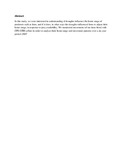| dc.identifier.citation | Tuqa, J. H., Funston, P., Musyoki, C., Ojwang, G. O., Gichuki, N. N., Bauer, H., ... & de Iongh, H. H. (2014). Impact of severe climate variability on lion home range and movement patterns in the Amboseli ecosystem, Kenya. Global Ecology and Conservation, 2, 1-10. | en_US |
| dc.description.abstract | In this study, we were interested in understanding if droughts influence the home range of predators such as lions, and if it does, in what ways the droughts influenced lions to adjust their home range, in response to prey availability. We monitored movements of ten lions fitted with GPS-GSM collars in order to analyze their home range and movement patterns over a six year period (2007–2012). We assessed the impact of a severe drought on the lion home range and movement patterns in the Amboseli ecosystem. There was a strong positive correlation between the home range size and distance moved in 24 h before and during the drought (2007–2009), while after the drought there was a significant negative correlation. A weak positive correlation was evident between the lion home range and rainfall amounts (2010–2012). The male and female home ranges varied over the study period. The home range size and movement patterns coincided with permanent swamps and areas of high prey density inside the protected area. Over the course of the dry season and following the drought, the ranges initially shrank and then expanded in response to decreasing prey densities. The lions spent considerable time outside the park boundaries, particularly after severe the drought. We conclude that under conditions of fragmented habitats, severe climate conditions create new challenges for lion conservation due to effects on prey availability and subsequent influences on carnivore species ranging patterns. Stochastic weather patterns can force wide-ranging species beyond current reserve boundaries, into areas where there will be greater conflicts with humans. | en_US |


